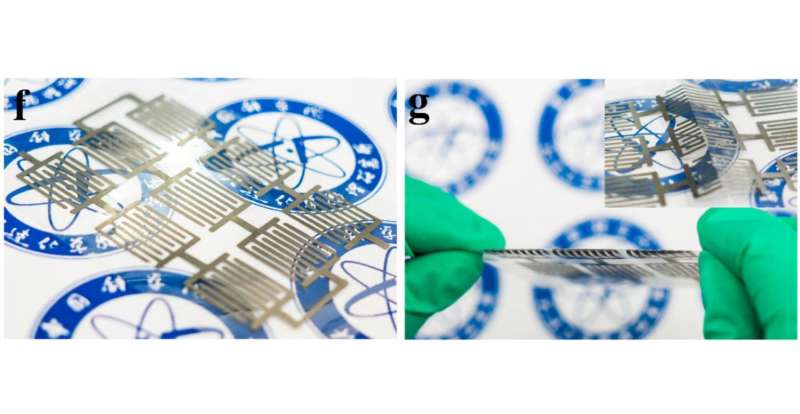(Left) Photograph of nine interconnected microsupercapacitors. (Right) Microsupercapacitors in a highly folded state. Credit: Xiao et al. ©2017 American Chemical Society
(Phys.org)—One of the most promising microscale power sources for portable and wearable electronics is a micro-supercapacitor—they can be made thin, lightweight, highly flexible, and with a high power density. Normally, however, manufacturing these devices involves complicated techniques that often require high pressures, irradiation, and multiple steps.
In a new study, researchers have developed a simple "one-step method" for fabricating micro-supercapacitors and demonstrate that the final devices exhibit a very good overall performance, including a high power density (1500 mW/cm3) as well as an energy density (11.6 mWh/cm3) that is at least twice as high as similar micro-supercapacitors.
The researchers, Han Xiao et al. at the Chinese Academy of Sciences, have published their paper in a recent issue of ACS Nano.
"We have developed a versatile, simple and effective method for fabricating high-energy micro-supercapacitors with designed shapes," coauthor Zhong-Shuai Wu at the Dalian National Laboratory for Clean Energy, Chinese Academy of Sciences, told Phys.org.
The essential step of fabricating the new micro-supercapacitor is integrating phosphorene nanosheets into the interlayer of graphene nanosheets, and the good performance is in large part due to the synergistic combination of these two materials. The different materials have complementary effects, with the phosphorene offering a high storage capacity and preventing the graphene sheets from unwanted stacking, while the graphene forms the main skeleton and offers a high-speed electron transport network.
Among their other characteristics, the micro-supercapacitors demonstrate very good flexibility, which the researchers attribute to the layered structure and planar device geometry. The device also has a high capacitance, which is maintained at nearly 90% of its maximum capacity after 2000 cycles. In general, the simple fabrication process also contributes to improving the device performance because it avoids the contamination and oxidation that often occur during multiple-step processing.
As the researchers explain, the small energy-storage devices have the potential to be used in a wide variety of areas.
"Micro-supercapacitors are very promising for on-chip energy storage," Wu said. "Very recently, the emergence of wearable and smart electronics urgently call for highly flexible and multi-functional, integrated energy storage devices. Overall, new micro-supercapacitors could keep up with the pace of the fast development of high-tech microsystems used in the precision instruments, materials, bio-medical and other fields."
The researchers also expect that, in the future, the new fabrication process can be easily scaled up and eventually be used for commercial purposes. They also plan to investigate other materials and techniques for developing microscale energy storage systems.
"We are continuously developing a variety of ultrathin, structurally defined graphene and 2-D materials, safe high-voltage electrolytes, and device fabrication techniques for flexible, smart, and integrated microscale energy storage device systems, such as high-energy micro-supercapacitors," Wu said.
More information: Han Xiao et al. "One-Step Device Fabrication of Phosphorene and Graphene Interdigital Micro-Supercapacitors with High Energy Density." ACS Nano. DOI: 10.1021/acsnano.7b03288
Journal information: ACS Nano
© 2017 Phys.org























